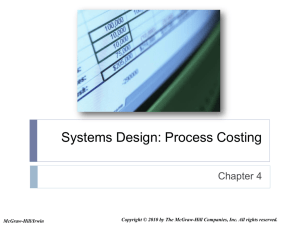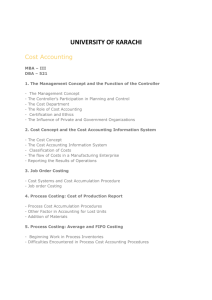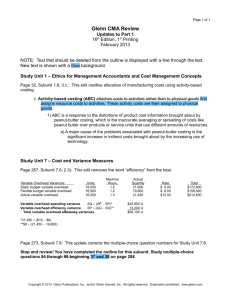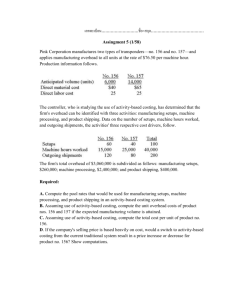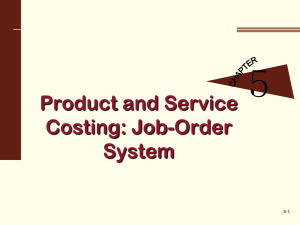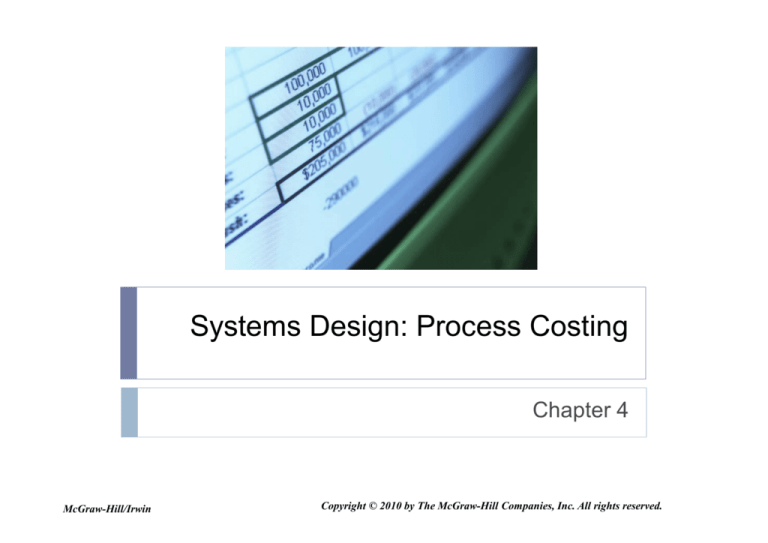
Systems Design: Process Costing
Chapter 4
McGraw-Hill/Irwin
Copyright © 2010 by The McGraw-Hill Companies, Inc. All rights reserved.
Similarities Between Job-Order and Process
Costing
Both systems assign material, labor and overhead costs
to products and they provide a mechanism for
computing unit product costs.
Both systems use the same manufacturing accounts,
including Manufacturing Overhead, Raw Materials, Work
in Process, and Finished Goods.
The flow of costs through the manufacturing accounts
is basically the same in both systems.
4-2
Differences Between Job-Order and Process
Costing
Process costing is used when a single product is
produced on a continuing basis or for a long period of
time. Job-order costing is used when many different jobs
having different production requirements are worked on
each period.
Process costing systems accumulate costs by department.
Job-order costing systems accumulated costs by
individual jobs.
Process costing systems compute unit costs by
department. Job-order costing systems compute unit
costs by job on the job cost sheet.
4-3
Comparing Job-Order and Process Costing
Direct
Materials
Direct Labor
Manufacturing
Overhead
Work in
Process
Finished
Goods
Cost of
Goods
Sold
4-4
Comparing Job-Order and Process Costing
Direct
Materials
Direct Labor
Manufacturing
Overhead
Costs are traced and
applied to departments
in a process cost
system.
Processing
Department
Finished
Goods
Cost of
Goods
Sold
4-5
Process Cost Flows: The Flow of Raw
Materials (in T-account form)
Raw Materials
•Direct
Materials
Work in Process
Department A
•Direct
Materials
Work in Process
Department B
•Direct
Materials
4-6
Process Cost Flows: The Flow of Labor
Costs (in T-account form)
Salaries and
Wages Payable
•Direct
Labor
Work in Process
Department A
•Direct
Materials
•Direct
Labor
Work in Process
Department B
•Direct
Materials
•Direct
Labor
4-7
Process Cost Flows: The Flow of Manufacturing
Overhead Costs (in T-account form)
Work in Process
Department A
Manufacturing
Overhead
•Actual
Overhead
•Overhead
Applied to
Work in
Process
•Direct
Materials
•Direct
Labor
•Applied
Overhead
Work in Process
Department B
•Direct
Materials
•Direct
Labor
•Applied
Overhead
4-8
Process Cost Flows: Transfers from
WIP-Dept. A to WIP-Dept. B (in T-account form)
Work in Process
Department A
•Direct
Transferred
Materials
to Dept. B
•Direct
Labor
•Applied
Overhead
Department
A
Work in Process
Department B
•Direct
Materials
•Direct
Labor
•Applied
Overhead
•Transferred
from Dept. A
Department
B
4-9
Process Cost Flows: Transfers from WIP-Dept.
B to Finished Goods (in T-account form)
Work in Process
Department B
•Direct
•Cost of
Materials
Goods
•Direct
Manufactured
Labor
•Applied
Overhead
•Transferred
from Dept. A
Finished Goods
•Cost of
Goods
Manufactured
4-10
Equivalent Units – The Basic Idea
Two half completed products are
equivalent to one complete product.
+
=
1
So, 10,000 units 70% complete
are equivalent to 7,000 complete units.
4-11
Equivalent Units of Production
Weighted-Average Method
The weighted-average method . . .
1. Makes no distinction between work done in prior
or current periods.
2. Blends together units and costs from prior and
current periods.
3. Determines equivalent units of production for a
department by adding together the number of
units transferred out plus the equivalent units in
ending Work in Process Inventory.
4-12
Compute and Apply Costs
The formula for computing the cost per
equivalent unit is:
Cost per
equivalent =
unit
Cost of beginning
Work in Process + Cost added during
Inventory
the period
Equivalent units of production
4-13
Operation Costing
Operation cost is a hybrid of jobjob-order and
process costing because it possesses attributes
of both approaches
Operation costing is
commonly used when
batches of many different
products pass through the
same processing
department.
4-14
End of Chapter 4
4-15

